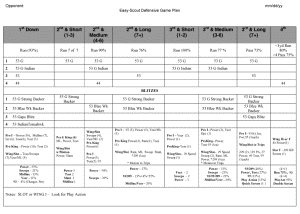AMERICAN FOOTBALL MONTHLY THE #1 RESOURCE FOR FOOTBALL COACHES
Article CategoriesAFM Magazine
|
Preparing your Defensive Game Planby: Nick Interdonato© More from this issue Every football coach, at one time or other during the season thinks “If only there were more time to prepare for this game, we could…”. DC’s are under great pressure each week to develop and implement a scheme that puts their players in the best possible position to make plays. This type of defensive game planning requires many hours of preparation – first breaking down game tape and determining an offense’s tendencies, and then selecting fronts, stunts and blitzes from the Defensive Scheme for the week. In high school football today, the most significant obstacle to effective and efficient defensive game plan development and implementation is limited time. This article discusses an approach to building and executing a defensive game plan. Collaborating to Build the Detailed Game Plan While many regular season games can be won with minimal preparation and by determining tendencies “by hand”, others, particularly post-season playoff games require more detailed preparation. When adequate staff resources and time are available for collecting scouting information, the “payback” for “breaking down” and entering scouting data into the computer can be significant. The best results are achieved when detailed game analysis is paired with a defensive scheme with plenty of “attack style” attributes – such as slants, twists, and blitzes. This makes the best use of scouting data to overload the expected offensive point of attack. Divide and Conquer – Spreading Game Planning Over the Week When a team utilizes a “multiple” defensive scheme, it is important for the defensive coordinator to be able to select fronts, coverages, blitzes and stunts as early in each game week as possible. This is the “What to Run” part of weekly game planning, and should be completed before Monday’s practice to allow adequate practice to minimize execution mistakes during the game. Many coaches will not need, or be able to use, a complete tendency report this early in the week and may be able to answer this “what question” by simply watching game tape. This makes it possible to distribute the more tedious game breakdown and computer data entry workloads among staff members, and over the course of a game week. When using a game planning chart like that shown (see chart below), my goal is to be able to fill in the detailed game breakdown form with the tendencies by Wednesday. This allows two days (Monday and Tuesday) for performing the type of detailed game analysis and scouting that reveals the 3 types of tendencies summarized in the Defensive Game Chart: Pass/Run, Play Type and Play Type by Formation – tendencies within each Down and Distance “situation.” Structuring Offensive Tendency Analysis My experience has been that some high school offensive coordinators will attempt to balance, or disguise their team’s Down and Distance tendencies or Formation tendencies, since they are fairly easy to determine. Its far more difficult, however for an OC to disguise the plays he runs in each Down and Distance situation in a particular Formation. By analyzing Formation tendencies by Down and Distance (such as Pro I on 1st and 10) tendencies are revealed that are not obvious when looking solely at Down and Distance or Formation breakdowns. To be sure, it's extremely difficult to determine these types of tendencies without some type of computer program, particularly when there are 100+ plays in the breakdown, which produces the best “statistical validity.” Using Tendencies to Build a Game Plan In addition to summarizing the tendencies by Down and Distance, the accompanying chart provides a structure for developing the “When to Call it” part of the game planning. Specifically, one or more Fronts, Stunts and Blitzes are selected for each situation based on what the opponent is expected to do, based on the games scouted. Creating a game plan in this fashion makes defensive “play calling” more scientific, since the calls are based on the results of detailed analysis done in the office, as opposed to “winging it” during the game. Bill Walsh is widely credited for advocating this approach to offensive play calling, as he argued that this type of decision making is better when done outside of the pressure of competition. Why should defense be any different? Maximizing Defensive Staff Utilization and Effectiveness During the Game A side benefit of structuring defensive play calling by Down and Distance situations is that it makes it possible to delegate much of the play calling responsibilities to an assistant coach on the sidelines, since most calls will be based on selecting from a couple of predetermined calls what is expected. This makes it possible to efficiently utilize assistant coaches on the sideline, and in the process turn a “get-back” coach into one that is actively engaged in each and every play of the game. A side benefit is that the defensive coordinator or head coach is “freed up” for other game time tasks, such as watching individual players, validating tendencies and making game time adjustments. Summary Whether your philosophy is to stay in your “base” Fronts and Coverages, or adapt your defense for each opponent, you can use detailed game analysis and a collaborative approach to game planning to remove some of the pressure each week. By identifying the “big picture” Formation and Play Tendencies before the week begins, it is possible to answer the “What to Run?” question and select components of a defensive scheme that are best suited for an opponent. This can and should be done before the practice week begins, leaving a few extra days to determine the more detailed Tendencies such as Down and Distance that help to answer the “When to Run it?” question. A Game Planning Chart like the one shown can be used to structure the information produced by a computer to make it easier to answer “The When question.” Game planning in this fashion is based on “science” and often puts players in the best possible position to make plays. Furthermore, by structuring the Defensive Play Calling by Down and Distance, it becomes possible to involve more coaches in the game while freeing up head coaches and defensive coordinators for other game time tasks. Football Coaches who are seeking to implement a more structured and collaborative approach to game planning may want to consider incorporating a Down and Distance “situation”- based approach, and structuring it like the Tendency/Game Plan chart discussed here. 
Click to Enlarge Nick Interdonato has 15 years of football coaching experience at the high school and college level. He began his coaching career at the high school level in 1979 and later coached linebackers and defensive ends at Susquehanna University. He founded CompuSports in 1984 to develop coaching software. After an 11 year hiatus, Interdonato returned to coaching in 1996 at Shippensburg University where he was an assistant for seven years. He returned to high school coaching in 2003 at Waynesboro HS (PA), coaching linebackers and tight ends and also serving as defensive coordinator. He can be reached at ninterdo@compusports.com. |
|
| HOME |
MAGAZINE |
SUBSCRIBE | ONLINE COLUMNISTS | COACHING VIDEOS |
Copyright 2024, AmericanFootballMonthly.com
All Rights Reserved




